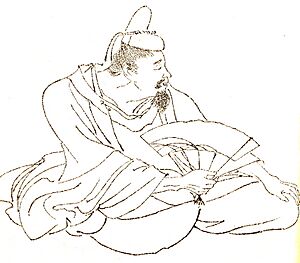Fujiwara no Sukemasa facts for kids
Quick facts for kids
Fujiwara no Sukemasa
藤原佐理 |
|
|---|---|

Illustration by Kikuchi Yōsai, from Zenken Kojitsu
|
|
| Born | 944 |
| Died | August 19, 998 |
| Family | Fujiwara Hokke |
| Father | Fujiwara no Atsutoshi (藤原敦敏) |
Fujiwara no Sukemasa (藤原 佐理, 944 – August 19, 998) was an important Japanese noble and a very skilled calligrapher during the middle Heian period. He was the grandson and adopted son of Fujiwara no Saneyori, a very high-ranking official. Sukemasa is famous as one of the Sanseki, a group of three outstanding calligraphers in Japanese history.
Contents
Sukemasa's Early Life and Career
In 961, Sukemasa began his career in the Japanese court. He was given a junior rank and became a chamberlain. A chamberlain was an official who served the emperor directly. He held a few minor military roles.
In 967, his adoptive father, Fujiwara no Saneyori, became a regent for the new Emperor Reizei. A regent was someone who ruled for the emperor when the emperor was too young or unable to rule himself. Because of his father's new role, Sukemasa was promoted to higher ranks in the same year and again in 968.
Rising Through the Ranks
When Emperor En'yū became emperor in 969, Sukemasa continued to rise in the government. He worked in the Daijō-kan, which was the main government office. In 978, he became a sangi, which meant he joined the group of top court nobles called the kugyō. By 984, he had reached the junior third rank, showing his importance.
However, during the time of Emperor Kazan and Emperor Ichijō, Sukemasa was not promoted as quickly as some other nobles. These nobles were relatives of the emperors, like Fujiwara no Yoshichika and later Fujiwara no Michitaka, Fujiwara no Michikane, and Fujiwara no Michinaga.
In 991, Sukemasa decided to leave his post as sangi. He moved to Kyushu to become the vice-minister of the Dazaifu. The Dazaifu was an important government office in Kyushu that managed the western part of Japan. In 992, he was promoted to the senior third rank.
Sukemasa passed away on August 19, 998, when he was 55 years old.
Sukemasa's Personality and Calligraphy
Sukemasa was known for his amazing calligraphy skills from a young age. He was especially good at cursive script, which is a flowing and artistic style of writing. His beautiful writing was used on special folding screens during important feasts for the coronations of Emperors En'yū, Kazan, and Ichijō.
He is considered one of the three greatest calligraphers of his time, known as the Sanseki. The other two were Ono no Michikaze and Fujiwara no Yukinari. Sukemasa's unique, lively handwriting style is called saseki (佐跡) in Japanese. Some of his original writings are still around today, including the National Treasures of Japan called Shikaishi (詩懐紙) and Rirakujō (離洛帖).
Stories About Sukemasa
The Ōkagami, an old Japanese historical tale, shares some stories about Sukemasa. One story tells how Sukemasa was returning to Kyōto from his work in Kyushu. He had a dream where he received a message from Ōyamazumi Shrine. After waking, he wrote the shrine's motto on its gate.
Another story describes how the regent Fujiwara no Michitaka asked Sukemasa to write a poem on a sliding screen for his new palace. However, Sukemasa arrived late, which upset Michitaka. These stories show that while he was a brilliant artist, he sometimes had his own way of doing things.
Famous Works of Calligraphy

Here are some of Fujiwara no Sukemasa's most famous works that still exist today:
- Shikaishi (詩懐紙): This work is held by The Kagawa Museum. A kaishi (懐紙) is a type of paper used for writing Chinese poetry or Japanese poetry in a special way. This is the only such work remaining from the entire Heian period.
- Rirakujō (離洛帖): This piece is kept at the Hatakeyama Memorial Museum of Fine Art. Sukemasa wrote it in 991 while he was traveling to Kyushu. He suddenly remembered that he had forgotten to say goodbye to the regent Fujiwara no Michitaka before leaving. In this letter, he apologized and asked his nephew, Fujiwara no Sanenobu (藤原誠信), to help smooth things over. The quick, flowing style of the cursive writing in this letter makes it very special.
- Onmeijō (恩命帖): This is a letter held by the Museum of the Imperial Collections.
- Kuni no Moushibumi-jō (国申文帖): This work is held by the Shogei Bunka-in (書芸文化院). Sukemasa wrote it in 982 when he was the governor of Iyo Province. It was a letter of apology to the regent Fujiwara no Yoritada. Sukemasa apologized for not doing his paperwork, leaving a New Year's party early, and missing Yoritada's daughter's wedding.
- Kyokajō (去夏帖): This is another letter written by Sukemasa.
- Tōbenjō (頭弁帖): This letter is held by the Fukuyama Museum of Calligraphy (ふくやま書道美術館蔵).
Sukemasa's Family Tree
- Father: Fujiwara no Atsutoshi (藤原敦敏)
- Mother: Daughter of Fujiwara no Motona (藤原元名)
- Wife: Fujiwara no Toshiko (藤原淑子), daughter of Fujiwara no Tamesuke (藤原為輔)
- Son: Fujiwara no Yorifusa (藤原頼房)
- Daughter: Wife of Fujiwara no Kanehira (藤原懐平)

